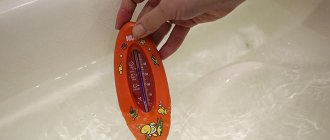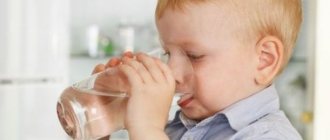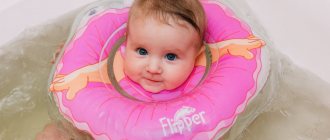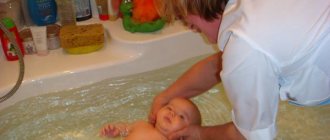Bathing the baby in a large bath
Most often, parents perceive the idea of bathing a newborn in a large bath with caution and therefore use a small bath. How does this type of bathing usually take place? In the kitchen, the burners are turned on at full power, the windows and doors are closed - God forbid, the child gets blown out! And in an atmosphere close to the hot and sultry Saharan desert, with shaking hands they quickly dip the baby into a small baby bath. The baby is still too young to protest. And there are no health benefits to speak of with such bathing.
What are the advantages of bathing in a large bath?
First of all, being in an adult bath, the baby finds himself in an environment familiar to him. And it’s not surprising: for 9 months, in this way, he “swimmed” in his mother’s tummy. In a large bathtub, the baby is not limited in his movements and can freely move his arms and legs. And movement is development. The muscles are trained, the endurance of the heart increases, and the entire body as a whole is strengthened. In addition, after active flopping, the child usually eats well and sleeps soundly, to the delight of mom and dad.
Bathing a baby after maternity hospital - what you need to know
Babies are discharged on the 3rd day of life, when the umbilical cord has not yet fallen off and the attachment site is moist.
When bathing a baby, water entering the area where the umbilical cord is attached or the wound creates a breeding ground for microbes, causing inflammation. Bathing a newborn is an essential component of care. His skin is thin and vulnerable, so microcracks easily appear on it. They may become infected.
Skin pores become clogged with secretions and fatty lubricants. Because of this, the heat exchange function and skin respiration become difficult. Water treatments are vital for a baby.
There are 2 options for water treatments for babies recently arrived from the hospital:
- Until the umbilical wound heals.
Bathing a newborn at home for the first time after discharge from the hospital is carried out without immersion in water on a changing table or other convenient place.
Place a warm soft diaper on the table. While undressing the child, talk to him. He knows your voice, he got used to it while you carried it under your heart. “Sound of Mom” has a calming effect.
The skin, axillary and inguinal folds are carefully wiped with a soft, damp mitten or terry cloth, avoiding the navel. After this, the remaining moisture is carefully blotted with a soft, dry, absorbent cloth.
- After complete scarring, a full bath is performed.
The kitchen is immediately excluded. Gas, stove, microwave will harm the baby. Suitable for a bathroom or living room. Make sure there are no drafts; you can close the windows and doors completely during the procedure.
There are two options:
- Baby bath. Its advantages: functionality, small space, easy to control the baby's movements. Perfect for the first time.
- Bath for adults. It is more convenient to use it when the child has already learned to sit. It is difficult to clean a large bathtub; it is difficult for a mother to bend over in the early postpartum period. There is no support for the baby.
READ MORE: How long do stitches last after childbirth?
Any time of day when the baby is awake is suitable for water procedures. You need to focus on the little one. The optimal time is before the last feeding of the night (between 22-24 hours).
Frequency of ablution
Newborn babies are bathed every day in summer, every other day in winter, and so on for up to 2 months. Skin lubricant is a barrier against bacteria, viruses, and protects against mechanical damage.
Prepare the swimming area in advance
We put a rubber mat on the bathroom floor to prevent you from slipping while holding your baby. You can put a small chair and bathe while sitting, without spoiling the process with back pain. But until you get the hang of it, at first it’s better to do without a high chair and bathe while standing. We don’t close the door to the bathroom! It is important. Otherwise, the baby may have problems with his ears when you take him out of the bathroom, as there will be a strong change in air humidity.
Before bathing, you should thoroughly clean the bathtub. It is advisable not to use any chemicals to avoid allergies in the baby. It is best to clean your bathtub with regular baking soda. It is enough to thoroughly treat the bathtub once a week; on other days, if no one has washed the bathtub and dirty laundry has not been soaked, you can only rinse with boiling water.
The most ordinary tap water is suitable for bathing; it is not necessary to boil it at all. If the water quality is poor, use faucet filters. Now let's talk about water temperature.
Why bubble bath is evil
Tests conducted with children's bath products have shown that they are ineffective - their softening and moisturizing properties are minimal, and the effect is comparable to washing with plain running water.
Margaret Cox, a representative of the British Eczema Society, advises to completely avoid all products with soap if the child has signs of a skin disease. She recommends washing your baby no more than twice a week, using special bathing oils and emollients.
University of Edinburgh professor Aziz Sheikh adds that you need to choose children's shampoos and bathing gels that do not contain perfumes or dyes. And bubble bath, from his point of view, is an absolute evil for children's skin.
The water should be cool
A large bathroom is ideal for starting to harden a child. Many parents know that this procedure is good for health, but do not know at what age they can start. It is better to start hardening from an early period of a baby’s life. Usually from the third week, when the umbilical wound has healed and you can start bathing. Seasoned children get sick less often, and mothers worry less and run with them to hospitals.
One Reply to “Bathing a newborn according to Komarovsky”
- Tatyana Gagarina
:December 21, 2014 at 7:21 am
Very informative, useful article. In fact, in the first months of a child’s life, it is very important not to be lazy and bathe the baby every day. My son was born small, only three kilograms, and in the maternity hospital they advised me, in order for him to get stronger faster and eat well, to bathe him twice a day, morning and evening before bed, which I did, my baby gained a whole kilogram in a month. And at one and a half months we went and learned to dive, first in a large bowl, and then in a pool. But the article does not indicate from what period you can use detergents, such as soap or shampoo? I washed my baby's head with shampoo for the first time when he was two weeks old.
Answer
We bathe the baby daily
Even if your hot water is turned off, you have no strength and want to finally hide in a dark corner and relax, instead of organizing swimming marathons - you need to bathe your child every day! If there is no hot water, boil it in buckets to fill the bath at least halfway. Your efforts will not be in vain. You are investing in your baby's health.
Now let's decide on the ideal time for water procedures. The optimal period is before night feeding. The baby, having spent a lot of energy in the cool water, eats with pleasure and sleeps for many hours in a row. And mom will have a chance to finally get some sleep. Sleeping 5-6, or even more hours in a row for a nursing mother of a newborn is a gift that one could only dream of before.
Bathing together - are there any advantages?
It happens that children have a very negative attitude towards the bathing process.
And parents have no choice but to dive into the bath together with their baby. This way the child will feel your warmth and care, he will be more comfortable.
Sometimes babies like to bathe in their mother's arms in the shower. Which also has a beneficial effect on the psyche.
In the absence of mother during the day, swimming together can compensate for the lack of attention with the help of various water games.
Water itself has calming properties, develops the sense of touch and provides tactile stimulation, and relieves hypertonicity of the limbs. If you add the presence of your mother to this, then you can practice diving, if the bath allows.
Very useful and relevant information on how to bathe a newborn and what is required for this procedure is contained in the article by a children's doctor.
We do massage, do gymnastics
Massage and gymnastics before bathing are an additional source of health for your baby. The duration of the massage is 10-15 minutes, a suitable place is a changing table.
We do the massage in the following order:
- we lay the naked newborn on his back and stroke the legs with our hands, then the arms, but without force;
- turn over onto the tummy and again stroke the legs and arms, then the buttocks;
- then back again and stroke the tummy clockwise with four fingers, excluding the thumb. To do this, it is convenient to place the base of your hand on the baby's pubis. After this, we stroke the chest, neck and head;
- Now everything is the same, but we are no longer stroking, but stretching the muscles.
Water temperature when bathing a newborn
Bathing water for a newborn should not be the same as for an adult. Babies' skin is more sensitive, and a comfortable temperature for you will be boiling water for your baby.
Many parents do not use a thermometer and regulate the temperature of the water by immersing their hand in it. But it is too difficult, and not everyone manages to achieve the perfect result.
It is recommended to start bathing at a temperature of 36 degrees, for the second wash lower it by 1 degree, for the third - by another 1-2, and so on until you reach 28 degrees.
We organize the bathing process correctly
We immerse the child in the water so that only the head remains on the surface. If water gets into your ears, don’t worry, there is no danger. Usually the baby is bathed in the following positions:
- We swim on our backs. We hold only the baby’s head: with our little finger under the neck, with the rest of our fingers we hold the back of the head. You will notice that in this position, the baby’s body does not sink, but floats to the surface. Therefore, with the other hand we immerse the body in the water.
- We swim on our tummy. We spread the thumb and index fingers of one hand so that the child’s chin fits. We also hold only the head.
- We are sitting. Surprisingly, it turns out that a baby can sit in a large bathtub already in the newborn period.
The approximate duration of water procedures at the initial stage is 15 minutes, and by the end of 4 weeks we increase it to 20-25 minutes. But don’t forget to monitor the baby’s reaction; if the baby swims calmly for more than the allotted time, then we extend the process, but there is no point in bathing for more than 40 minutes. Also monitor how your newborn reacts to the temperature of the water. If he lies relaxed, does not move and yawns in addition, then the water is warm for him, and therefore you can cool it further.
If your baby doesn’t like bathing and cries a lot, then experiment with the duration, temperature or time of bathing. For example, bathe an hour after your baby has eaten. We remember the golden rule - to do without violence, so we try to find optimal conditions.
Let's move on to hygiene procedures. Washing the child at the end of the bath. We lather it directly in the water with baby shampoo or soap, and then everything is simple. One of the parents holds the baby under his arms, and the other pours a bucket of water on him. It's time to dry.
What should a baby's bath be like?
While expecting the birth of a child, we buy everything we can get our hands on in baby stores. And in most cases, many things remain unnecessary, and we realize that we wasted our money. So the question about buying a bath for a newborn remains relevant.
The bathtub is convenient for parents because it can be installed at any height in order to comfortably wash their beloved child. But this is only for the first time, for about a month or two, until the child realizes that it is more interesting not just to swim, but to splash and swim. And then the parents will begin to suffer: to hold the baby, to catch him without letting him slip out, to wipe a ton of water from the floor.
The opinion of many “experienced” parents is this: don’t waste money on a bathtub, it’s a useless thing!
But what should we do? At first, a newborn can be bathed in a regular sink, plugging the drain with a stopper. Place a towel on the bottom to prevent your baby's bottom from slipping, and enjoy washing. In the first month of life, bathing a newborn is a common hygienic procedure, and the volume of the sink will be quite enough.
But from a month on, you can wash your baby in a regular bath, letting him splash freely in the water. Buy an inflatable ring that holds the baby, which will allow you to free your hands without worrying about the life of the child.
We do not dry the baby in the bath
We take the baby under the armpits, throw a diaper over his head and take the wet one to the children's room on the changing table. The diaper should be large enough to wrap the whole baby in it. This is another secret of hardening. Now we don’t wipe, but blot the skin so that it dries.
After the newborn has dried, you need to treat all folds of skin on the body with vegetable oil, boiled in a water bath, or a special baby olive oil with a cotton pad.
All! You have read the basic advice of Dr. Komarovsky on how to properly bathe and condition a child. Now let’s imagine ourselves in the place of the baby. He splashed a lot and was tired, they wiped him dry and he was already warm, his appetite worked up and he was deliciously fed with his mother’s milk. After so much work, both the baby and the parents can sleep sweetly with a clear conscience!
Is it possible to bathe a newborn until the umbilical wound has healed?
There are so many people here, so many opinions, even pediatricians cannot come to a consensus. Some believe that you should not wash your baby until his navel has dried out and the crust has come off. At this time, it is recommended to replace bathing with wiping with wet wipes.
Others claim that you can bathe a newborn with a wound that has not yet healed. You just need to add a little potassium permanganate to the water to disinfect it.
Yes, the belly button heals only 10-14 days after the baby is born, and it is simply unacceptable to deny him the pleasure of bath procedures. Start bathing at 4-5 days old, boil the water, add potassium permanganate, and everything will be fine! Do not be afraid that you can get an infection, the navel is tightly closed, and the manganese will dry out the crust.
Many people continue to boil water and add manganese for up to six months, some for up to a month. Don’t waste your energy in vain; stop boiling as soon as the baby’s belly button has completely healed. And manganese will no longer be needed. If you are really worried, add a decoction of chamomile or celandine to your bath.
Wet wipes cannot clean the baby's skin well, so it is worth starting bathing from 4-5 days, this will prevent skin problems - dryness, irritation and inflammation (especially if the baby almost always wears a diaper).










